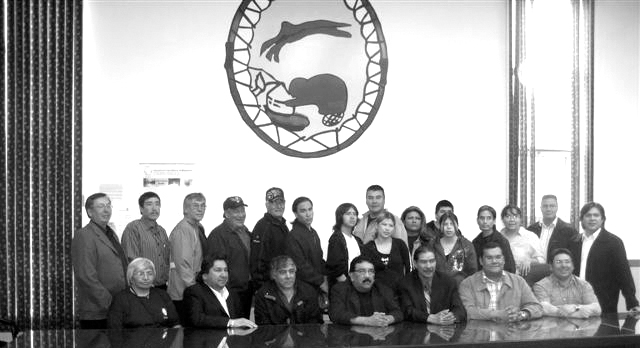
On June 5, The Grand Council of the Crees and the Tataskweyak Cree Nation of Manitoba signed a declaration to affirm ties of kinship and cooperation between the two Nations. But this was more than a simple expression of friendship.
Grand Chief Matthew Mukash noted the declaration could be interpreted as a form of protest. Mukash and the Manitoba Chief recognized each other as Nations. “This is a first where we agreed to recognize each other and our inherent right to self-government. It is going to be an effective tool,” said Mukash.
The text itself reads, “In shaping our own destinies, we will remain faithful to the time honoured traditions of our ancestors and we will work to secure the greatest possible freedom, dignity and prosperity for our people.”“The Tataskweyak want to learn from us and how we handled certain issues that affect all First Nations, especially in regards to development,” said Mukash.
Indeed it was development that brought the new relationship between the two Cree Nations together as Jack Blacksmith, Chairperson of Creeco, can attest. “We started talking to the Tataskweyak Cree a few years back, and about a year ago things started to happen. In the third week of March last year, an agreement outlining a joint venture between Cree Construction and Tataskweyak Cree Nation was signed creating a United Cree Construction Company based in Manitoba.
“We hoped we would start working together and we did. We got contracts from Manitoba Hydro,” said Blacksmith. The first contract was a $2.5 million deal to restore a cemetery endangered by fluctuating water levels. The next contract will be community roads and infrastructure, according to Blacksmith, with the possibility of other co-ventures on Manitoba Hydro contracts.
Blacksmith said the relationship is a good one. “Cree expertise is being shared. We’re not there to take over but to share our knowledge.”
Cree Construction president William MacLeod said they saw this as an opportunity to assist the Tataskweyak Band to buildcapacity so the Tataskweyak Cree would be able to take advantage of opportunities in their territories and beyond.
“It’s more than just business,” said MacLeod. He said there would be cultural and people exchanges. For example the Tataskweyak youth might be interning at the Cree Regional Radio for a few weeks to get some training. “Culturally, some of their Elders remembered some of the traditional cooking methods and styles we were using. Some of the Youth had never even seen the bonask or smoked or spinning goose,” said MacLeod. Many of the Elders enjoyed beaver tail, saying they had not had it in decades.
One Tataskweyak Elder said he thought everyone was going on the right path. “We are not just looking at making money here and this is a good thing,” he said.
It was this attitude that saw the Tataskweyak Band Council asking for more and led to the declaration in the first place. “The Council wanted to look at the whole Eeyou/Ennou experiences and scenario that we went through. As a result we helped to facilitate meetings between the Grand Council of the Cree of Eeyou Istchee and the Tataskweyak Cree,” said Blacksmith.
While the Agreement recognizes “our own distinct identities, culture, language and traditions,” in the same sentence it says they have been guided by common purposes and beliefs, “which have been shaped by many common experiences.”
Mukash fully agrees with that sentiment. “We knew we were alike in certain ways and we agreed to work together,” said Mukash. He said both Nations want to protect their way of life while looking at development. “It’s about our way of life and treaty rights. There are principles that will guide us. It’s an important step for both our Nations,” said Mukash.
Mukash said they are looking at visiting the Tataskweyak traditional lands later in the fall.

